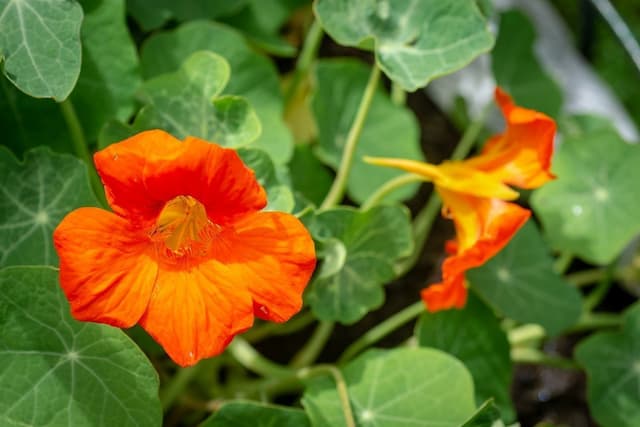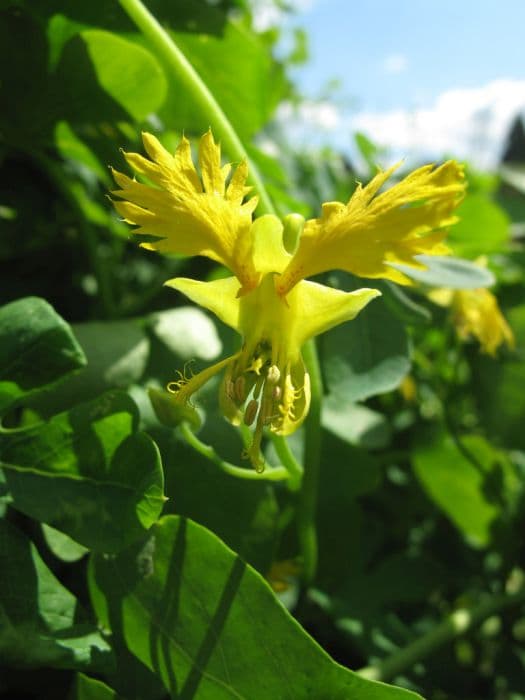Nasturtium Tropaeolum majus Whirlybird Series

ABOUT
The common name for Tropaeolum majus Whirlybird Series is Nasturtium. This variety is known for its vibrant and colorful appearance, which makes it a popular choice for gardeners looking to add a splash of color to their gardens. The plant bears rounded leaves that appear almost like small lily pads, being nearly circular with a smooth texture and a soft green color. From among these leaves emerge striking flowers on singular, sturdy stems. The Whirlybird Series is characterized by its flowers that come in a palette of bold hues including red, orange, yellow, and cream. Each flower has a funnel-like shape with a spur at the rear, and the petals are often marked with unique, contrasting blotches or veins that enhance their beauty. The overall impression of the plant is one of cheerful brightness and lushness, with the flowers creating a vivid display that is particularly attractive to pollinators like bees and hummingbirds. The foliage, while being ornamental on its own, provides an excellent backdrop to the showy blooms.
About this plant
 Names
NamesSynonyms
Garden Nasturtium, Indian Cress, Monks Cress
Common names
Tropaeolum majus.
 Toxicity
ToxicityTo humans
Nasturtium, which is the common name of Tropaeolum majus Whirlybird Series, is not considered toxic to humans. In fact, the leaves and flowers are often used in culinary dishes for their peppery flavor. However, as with any plant, individual allergies or sensitivities could potentially cause adverse reactions if ingested. It is always best to exercise caution and consult with a healthcare provider if you experience symptoms after consuming any part of a plant with which you are not familiar.
To pets
Nasturtium, the common name of Tropaeolum majus Whirlybird Series, is generally not toxic to pets such as dogs and cats. The plant is often considered safe and non-toxic, and some pet owners may even use the leaves and flowers as a low-calorie treat. However, if a pet ingests a large amount of the plant, it could possibly experience mild gastrointestinal upset. If you notice your pet showing any signs of distress after consuming any part of the nasturtium, it is advisable to contact your veterinarian.
 Characteristics
CharacteristicsLife cycle
Annuals
Foliage type
Deciduous
Color of leaves
Green
Flower color
Varies
Height
1 foot (30 cm)
Spread
1 foot (30 cm)
Plant type
Herb
Hardiness zones
9
Native area
Central and South America
Benefits
 General Benefits
General Benefits- Easy to Grow: Tropaeolum majus Whirlybird Series is known for being easy to grow, making it suitable for gardeners of all experience levels.
- Edible Flowers: Nasturtium offers edible flowers that can add a peppery flavor to salads and garnishes.
- Pest Deterrent: Nasturtiums naturally repel certain pests, reducing the need for chemical insecticides in the garden.
- Attracts Beneficial Insects: The plant attracts pollinators like bees and butterflies, enhancing pollination of other plants in the garden.
- Colorful Blossoms: Nasturtium produces vibrant flowers that can aesthetically improve the look of gardens and landscapes.
- Companion Planting: When planted near vegetables and fruits, it can improve their growth and flavor through companion planting benefits.
- Soil Improvement: Nasturtium can help in improving the soil quality by adding biomass when the plants decompose.
 Medical Properties
Medical Properties- Antibacterial - Used traditionally to combat bacterial infections, especially in the urinary tract.
- Antifungal - Applied to manage fungal infections like ringworm due to its antifungal activity.
- Antiscorbutic - High in vitamin C, it's historically been used to prevent and treat scurvy.
- Expectorant - Believed to help clear mucus from the respiratory system, aiding in common cold and flu symptoms.
- Wound healing - The leaves applied as poultices were used traditionally for their healing properties on cuts and wounds.
- Diuretic - May increase urine production, used in traditional medicine to help with urinary system issues.
- Mild Analgesic - Chewed leaves may have been used to alleviate minor pain like toothaches.
 Air-purifying Qualities
Air-purifying QualitiesThis plant is not specifically known for air purifying qualities.
 Other Uses
Other Uses- Nasturtiums are often used as a trap crop in gardens. They attract pests such as aphids, keeping them away from other more valuable plants.
- The leaves and flowers of nasturtiums can be used to create a vibrant, natural dye for fabrics and paper.
- Nasturtium seeds can be pickled in vinegar and used as a substitute for capers in various recipes.
- The peppery taste of nasturtium leaves makes them an interesting addition to cocktails, especially to infuse gin or vodka.
- Nasturtiums can be planted as companion plants to deter certain pests and insects from vegetables such as cucumbers and tomatoes.
- The bright flowers of nasturtiums can be frozen in ice cubes to create an attractive and edible garnish for summer drinks.
- Nasturtium leaves can be used as a mold to create chocolate or sugar decorations by brushing them with the material and peeling it off once set.
- Pressed nasturtium flowers can be used in craftwork, such as creating bookmarks or enhancing the visual appeal of homemade cards and scrapbooks.
- When planted in poor soil, nasturtiums can serve as a natural soil improver as they have a tendency to gather trace elements and minerals.
- Due to their vibrant color and abundant blooms, nasturtiums can be used as an organic method for color coding different areas in a garden or farm.
Interesting Facts
 Feng Shui
Feng ShuiThe Nasturtium is not used in Feng Shui practice.
 Zodiac Sign Compitability
Zodiac Sign CompitabilityThe Nasturtium is not used in astrology practice.
 Plant Symbolism
Plant Symbolism- Victory in Battle: The Latin name "Tropaeolum" originates from "tropaion" where the ancient Greeks would celebrate a victory in battle by displaying the armor and weapons of defeated foes on a tree. They called this the "tropaeum," which is echoed in the plant's resemblance to a soldier's helmet.
- Conquest and Triumph: As an extension of its association with victory, the Nasturtium embodies themes of conquest and triumph, which might pertain to overcoming obstacles in one's personal life or achieving success against the odds.
- Vibrancy and Vitality: The bright and vivid colors of the Nasturtium are symbolic of life's energy and the spark of enthusiasm, reminding us to approach our endeavors with vigor and passion.
- Optimism: The cheerful appearance of the Nasturtium, with its bold colors, inspires an optimistic outlook and suggests a positive attitude in the face of challenges.
- Courage and Bravery: The resemblance of the Nasturtium to a helmet also conveys a sense of courage and bravery, encouraging us to face adversity with fortitude.
 Water
WaterNasturtiums prefer moderate watering. During the growing season, water with roughly 1 gallon per week, depending on the weather conditions. Always check the top inch of soil for dryness before watering; if it's dry, it's time to water. Nasturtiums are drought tolerant, so overwatering can be detrimental, potentially leading to root rot. In hotter climates, they may require more frequent watering to keep the soil consistently moist.
 Light
LightNasturtiums thrive in full sun to partial shade. They perform best with at least 6 hours of direct sunlight daily, which encourages abundant flowering. However, in scorching climates, they appreciate some afternoon shade to protect them from intense heat. Choose a spot that receives bright and direct morning light but might be slightly shielded during the hottest part of the day.
 Temperature
TemperatureNasturtiums grow well in temperatures between 55°F and 75°F. They can manage short periods of colder weather down to 40°F but will decline if subjected to frost. During hot summer days when temperatures exceed 85°F, nasturtiums may stop producing flowers and go dormant. They revive when cooler temperatures return in the fall.
 Pruning
PruningPruning nasturtiums can encourage a bushier growth habit and more blooms. Pinch back the tips of the stems early in the season to stimulate branching. Remove faded or dead flowers regularly to promote continuous blooming. Pruning is not usually necessary, but if the plants become leggy or overgrown, they can be cut back by half in the midseason to rejuvenate them.
 Cleaning
CleaningAs needed
 Soil
SoilNasturtiums prefer a well-draining soil mix with some added compost for nutrients. A soil pH of 6.1 to 7.8 is ideal for Tropaeolum majus Whirlybird Series, ensuring a slightly acidic to neutral environment for optimal growth.
 Repotting
RepottingNasturtiums from the Tropaeolum majus Whirlybird Series typically do not require frequent repotting as they are annuals. Repotting is usually done annually when sowing new seeds or transplanting seedlings.
 Humidity & Misting
Humidity & MistingNasturtiums thrive in moderate humidity levels but are quite adaptable. For the Tropaeolum majus Whirlybird Series, the ideal humidity range is between 40-70%, which is often found in outdoor environments.
 Suitable locations
Suitable locationsIndoor
Nasturtiums need full sun, less water, and a well-draining pot indoors.
Outdoor
Provide full sun, well-drained soil, and water sparingly outdoors.
Hardiness zone
9-11 USDA
 Life cycle
Life cycleNasturtium (Tropaeolum majus Whirlybird Series) begins its life when the seeds are sown in well-draining soil after the last frost has passed. Germination occurs within 10-14 days in warm soil, after which seedlings emerge with their first set of true leaves. As the plant grows, it develops a bushy form with rounded leaves and stems that can either climb or spread across the ground. The nasturtium flowers from early summer to fall, producing vibrant, edible flowers that attract pollinators. After flowering, the plant sets seed in the form of a small, wrinkled capsule which can be collected for planting the next season. The nasturtium is an annual plant and completes its life cycle within one growing season, dying off with the first frost.
 Propogation
PropogationPropogation time
Spring to early summer
Propogation: Tropaeolum majus, commonly known as nasturtium, is typically propagated by seed. The most popular method is to sow the seeds directly into the garden soil where they are to grow. This is usually done in late spring after all danger of frost has passed. Seeds should be planted about 1/2 inch deep (approximately 1.3 centimeters) and spaced 10 to 12 inches apart (25 to 30 centimeters). Nasturtium seeds have a hard coat, so soaking them in water overnight before planting can speed up germination. After sowing, the seeds usually germinate within 10 to 14 days, and the plants will start flowering about six to eight weeks later. This direct-sowing method takes advantage of their preference for not being transplanted due to their sensitive root systems.




